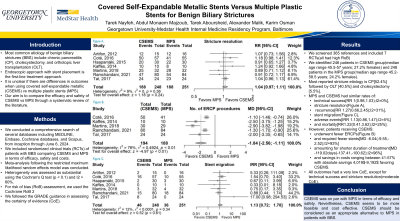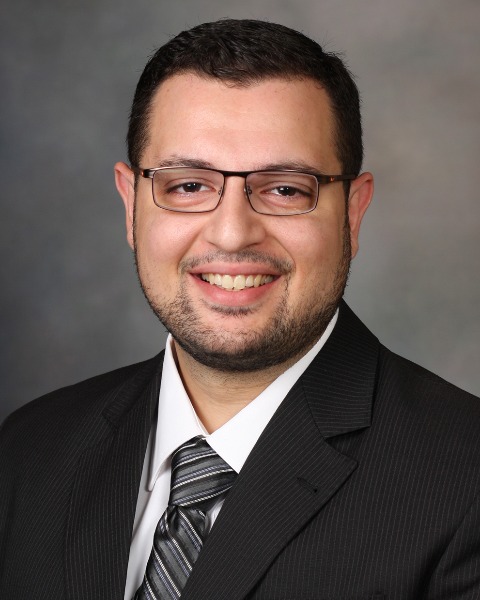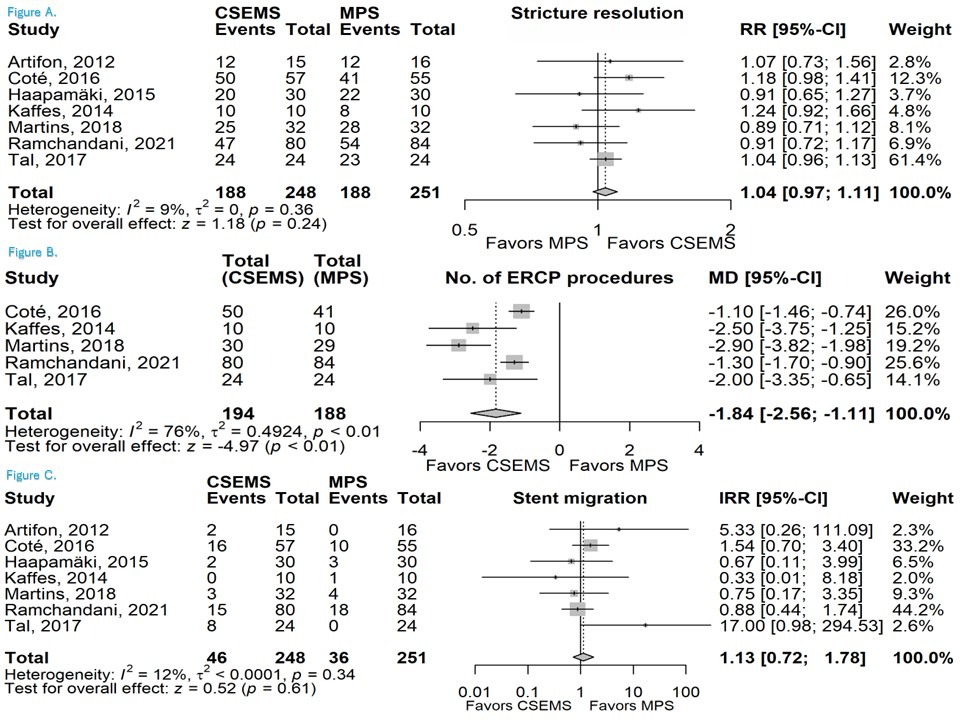Monday Poster Session
Category: Interventional Endoscopy
P2772 - Covered Self-Expandable Metallic Stents versus Multiple Plastic Stents for Benign Biliary Strictures
Monday, October 28, 2024
10:30 AM - 4:00 PM ET
Location: Exhibit Hall E

Has Audio

Tarek Nayfeh, MD
MedStar Union Memorial Hospital
Towson, MD
Presenting Author(s)
Tarek Nayfeh, MD1, Abdul Monaem Majzoub, MD2, Tarek Aboursheid, MD3, Alexander Malik, MD4, Karim T.. Osman, MD5, Leslie C. Hassett, 6, Nabil Noureddin, MD7
1MedStar Union Memorial Hospital, Towson, MD; 2University of Missouri School of Medicine, Columbia, MO; 3Ascension Saint Francis Hospital, Evanston, IL; 4Case Western Reserve University / MetroHealth, Cleveland, OH; 5Lahey Hospital and Medical Center, Burlington, MA; 6Mayo Clinic, Rochester, MN; 7University of California San Diego School of Medicine, La Jolla, CA
Introduction: There are multiple etiologies leading to benign biliary strictures (BBS)–most commonly include chronic pancreatitis (CP), cholecystectomy, and orthotopic liver transplantation (OLT). BBS can lead to jaundice, cholangitis, and cirrhosis. Endoscopic approach with stent placement is the first-line treatment approach. It is unclear if there are differences in outcomes when using covered self-expandable metallic (CSEMS) vs multiple plastic stents (MPS). Our aim is to compare the efficacy and safety of CSEMS vs MPS through a systematic review of the literature.
Methods: We conducted a comprehensive search of several databases including MEDLINE, Embase, Cochrane databases, and Scopus, from inception through June 6, 2024. We included randomized clinical trials (RCTs) of patients with BBS comparing CSEMS and MPS in terms of efficacy, safety and costs. When appropriate, meta-analysis following the restricted maximum likelihood random effects model was conducted. Heterogeneity was assessed as substantial using the Cochran's Q test (p < 0.1) and I2 > 60%. For risk of bias (RoB) assessment, we used the Cochrane RoB 2 and followed the GRADE guidance in assessing the certainty of evidence (CoE).
Results: After screening 365 references, we included 7 RCTs(all had high RoB) involving 246 patients in CSEMS group(median age range 45.5-57 years; 27.2% females) and 248 patients in the MPS group(median age range 45.2-58.5 years; 24.2% females). Most reported stricture etiology is CP[52.4%] followed by OLT [40.5%] and cholecystectomy [5.5%]. Compared to MPS, CSEMS achieved similar results in terms of technical success[RR 1(0.98,1.03);I2=0%], stricture resolution(FigureA), recurrence[RR 1.27(0.66,2.45);I2=31%], stent migration(FigureC), adverse events[IRR 1.13(0.86,1.47);I2=5%] and all-cause mortality[RR 1.22(0.41,3.62);I2=25%]. However, patients receiving CSEMS underwent fewer ERCPs(FigureB) and required fewer stents[MD -6.04(-9.55,-2.52);I2=93%] amounting for shorter duration of treatment[MD -119.02 days (-137.41,-100.62);I2=96%] and savings in costs ranging between 41-57% with absolute savings 4,019$-9,192$ favoring CSEMS. All outcomes had a very low CoE, except for technical success and stricture resolution(moderate CoE).
Discussion: Treating BBS with CSEMS was on par with MPS in terms of efficacy and safety. Nevertheless, CSEMS seems to be more feasible and cost effective. CSEMS should be considered as an appropriate alternative to MPS in patients with BBS.

Disclosures:
Tarek Nayfeh, MD1, Abdul Monaem Majzoub, MD2, Tarek Aboursheid, MD3, Alexander Malik, MD4, Karim T.. Osman, MD5, Leslie C. Hassett, 6, Nabil Noureddin, MD7. P2772 - Covered Self-Expandable Metallic Stents versus Multiple Plastic Stents for Benign Biliary Strictures, ACG 2024 Annual Scientific Meeting Abstracts. Philadelphia, PA: American College of Gastroenterology.
1MedStar Union Memorial Hospital, Towson, MD; 2University of Missouri School of Medicine, Columbia, MO; 3Ascension Saint Francis Hospital, Evanston, IL; 4Case Western Reserve University / MetroHealth, Cleveland, OH; 5Lahey Hospital and Medical Center, Burlington, MA; 6Mayo Clinic, Rochester, MN; 7University of California San Diego School of Medicine, La Jolla, CA
Introduction: There are multiple etiologies leading to benign biliary strictures (BBS)–most commonly include chronic pancreatitis (CP), cholecystectomy, and orthotopic liver transplantation (OLT). BBS can lead to jaundice, cholangitis, and cirrhosis. Endoscopic approach with stent placement is the first-line treatment approach. It is unclear if there are differences in outcomes when using covered self-expandable metallic (CSEMS) vs multiple plastic stents (MPS). Our aim is to compare the efficacy and safety of CSEMS vs MPS through a systematic review of the literature.
Methods: We conducted a comprehensive search of several databases including MEDLINE, Embase, Cochrane databases, and Scopus, from inception through June 6, 2024. We included randomized clinical trials (RCTs) of patients with BBS comparing CSEMS and MPS in terms of efficacy, safety and costs. When appropriate, meta-analysis following the restricted maximum likelihood random effects model was conducted. Heterogeneity was assessed as substantial using the Cochran's Q test (p < 0.1) and I2 > 60%. For risk of bias (RoB) assessment, we used the Cochrane RoB 2 and followed the GRADE guidance in assessing the certainty of evidence (CoE).
Results: After screening 365 references, we included 7 RCTs(all had high RoB) involving 246 patients in CSEMS group(median age range 45.5-57 years; 27.2% females) and 248 patients in the MPS group(median age range 45.2-58.5 years; 24.2% females). Most reported stricture etiology is CP[52.4%] followed by OLT [40.5%] and cholecystectomy [5.5%]. Compared to MPS, CSEMS achieved similar results in terms of technical success[RR 1(0.98,1.03);I2=0%], stricture resolution(FigureA), recurrence[RR 1.27(0.66,2.45);I2=31%], stent migration(FigureC), adverse events[IRR 1.13(0.86,1.47);I2=5%] and all-cause mortality[RR 1.22(0.41,3.62);I2=25%]. However, patients receiving CSEMS underwent fewer ERCPs(FigureB) and required fewer stents[MD -6.04(-9.55,-2.52);I2=93%] amounting for shorter duration of treatment[MD -119.02 days (-137.41,-100.62);I2=96%] and savings in costs ranging between 41-57% with absolute savings 4,019$-9,192$ favoring CSEMS. All outcomes had a very low CoE, except for technical success and stricture resolution(moderate CoE).
Discussion: Treating BBS with CSEMS was on par with MPS in terms of efficacy and safety. Nevertheless, CSEMS seems to be more feasible and cost effective. CSEMS should be considered as an appropriate alternative to MPS in patients with BBS.

Figure: FigureA: Forest plot showing 7 RCTs comparing CSEMS and MPS in terms of stricture resolution and the result of the random effects meta-analysis: no difference between CSMES and MPS. RR: relative risk.
FigureB: Forest plot showing 5 RCTs comparing CSEMS and MPS in terms of number of ERCP procedures and the result of the random effects meta-analysis: fewer ERCP procedures needed in the CSMES vs MPS group. MD: mean difference.
FigureC: Forest plot showing 7 RCTs comparing CSEMS and MPS in terms of stent migration and the result of random effects meta-analysis: no difference between CSMES and MPS. IRR: incidence rate ratio.
FigureB: Forest plot showing 5 RCTs comparing CSEMS and MPS in terms of number of ERCP procedures and the result of the random effects meta-analysis: fewer ERCP procedures needed in the CSMES vs MPS group. MD: mean difference.
FigureC: Forest plot showing 7 RCTs comparing CSEMS and MPS in terms of stent migration and the result of random effects meta-analysis: no difference between CSMES and MPS. IRR: incidence rate ratio.
Disclosures:
Tarek Nayfeh indicated no relevant financial relationships.
Abdul Monaem Majzoub indicated no relevant financial relationships.
Tarek Aboursheid indicated no relevant financial relationships.
Alexander Malik indicated no relevant financial relationships.
Karim Osman indicated no relevant financial relationships.
Leslie C. Hassett indicated no relevant financial relationships.
Nabil Noureddin indicated no relevant financial relationships.
Tarek Nayfeh, MD1, Abdul Monaem Majzoub, MD2, Tarek Aboursheid, MD3, Alexander Malik, MD4, Karim T.. Osman, MD5, Leslie C. Hassett, 6, Nabil Noureddin, MD7. P2772 - Covered Self-Expandable Metallic Stents versus Multiple Plastic Stents for Benign Biliary Strictures, ACG 2024 Annual Scientific Meeting Abstracts. Philadelphia, PA: American College of Gastroenterology.
